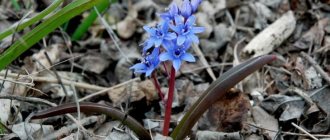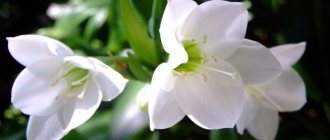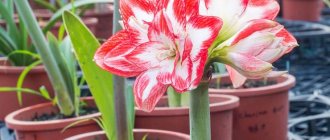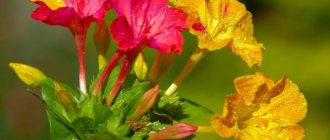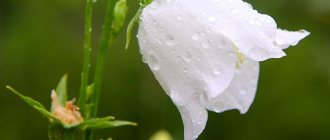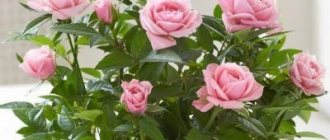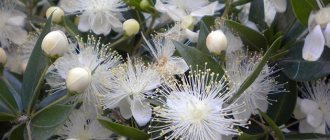Types and varieties of blueberries
Scylla is a flower with a wide variety of varieties (about 90). The types below are the most popular among gardeners.
| Variety | Description |
| Campanulate | It is most common in garden plots. The plant has a short stem (about 30 cm), on which from 5 to 10 bells can be located. |
| Hyacinth-shaped | It is characterized by a high density of inflorescences. This variety is often used for decorative purposes. |
| Siberian | The color range is varied: ovoid flowers can be pinkish, white or blue. The height of the stem is small, about 10 cm. |
| Grape | It is also sometimes called "Peruvian", native to the western edges of the Mediterranean Sea. These plants are distinguished by the presence of fairly large cone-shaped inflorescences of blue color. The leaves have a linear shape and taper towards the end. |
| Bifolia | Relatively low, about 15 cm. The shape of the flowers resembles stars and is blue, pink or white. |
| Proleskovidnaya | It blooms twice a year: in July and early autumn (from late August to October). Decorated with many small flowers of soft pink color. |
| Autumn | It has 5-6 light purple flowers and a cone-shaped inflorescence. The stem length is about 20 cm. |
| Italian | The ovoid shape of the bulb, long leaves pointed at the ends and a large number of pale blue flowers on a long stem. |
| Lithardier | The inflorescence has an oval shape with many light purple flowers. It blooms in July and, despite its rather attractive appearance, is not as popular as other scilla varieties. |
| Pushkiniformnaya | It got its name for its similarity with another flower - Pushkinia. It is considered one of the most persistent and undemanding; it has a not very long stem (about 15 cm). The leaves are linear, widening towards the middle. The racemose inflorescence contains no more than 10 pale blue flowers. Flowering occurs at the beginning of May. |
Description of the scilla
In nature, purple, pink, and white scylla are found, but the main color is blue. The species blooms with the arrival of spring, although there are autumn varieties. The blue snowdrop is called the blue snowdrop because the leaves appear while still in the snow - the plant is frost-resistant, capable of surviving in central Russia.
Scylla is classified as an ephemeral crop that, over a very short growing season, accumulates a supply of nutrients in the underground part - in this case, the bulb. In total, the period of growth and flowering for the blueberry is about a month. Then the aboveground part dies off completely, and the bulb lives until next year. Scilla can be found in high mountain areas, as well as in forests and steppes.
The leaves, which appear first in the spring, are dark green in color and elongated in shape, dense and leathery. The peduncle is symmetrical and resembles a bell. One inflorescence can contain up to 15 pieces.
Planting in open ground
As a rule, scylla is not planted individually: the plants are collected in flower beds or distributed around trees.
Time
Experienced gardeners recommend replanting spring scylla in open ground in mid-June, and autumn scylla - towards the end of August.
Place
You can plant flowers on both the sunny and shady sides. It all depends on the variety and flowering time: spring species prefer warmth and sun, while autumn species feel better in the shade and coolness.
During rainy or cool days, Scylla leaves are arranged horizontally and almost lie on the ground, while in sunny weather they stand vertically.
Scilla or Scylla in garden landscape design
Thanks to the tenderness of the inflorescences of Scilla, the perennial is widely used to decorate the spring garden. It looks good in single plantings, combining perfectly with the awakening greenery of shrubs and trees. It can also be used to organize group flower beds made up of primroses.
You can create a flower bed from flowers of different flowering times; when the Blue Scilla has faded, another type of plant may bloom in its place, for example, Peony, which will cover the Scilla's planting site with its lush crown.
The Scylla flower looks good cut and in spring bouquets. Its delicate buds and bright greenery will not leave any representative of the fair sex indifferent.
Care
Due to the fact that scylla is a picky plant, it only needs systematic watering and loosening of the soil. Weed control is also important.
The most successful time for watering is considered to be morning, the main thing is that the flowers are not flooded with water, otherwise it will have a bad effect on their appearance.
Don’t forget that blueberries reproduce from flowers, so their seeds need to be removed if the gardener does not want the flowers to spread to places not intended for this purpose.
It is better to fertilize when a particular species is in bloom, for example, spring plants are fed in early spring, and autumn plants in late August-early September.
Planting bulbs
Spring bulbous flowers are best planted in early fall. Before frost, the bulbs have time to take root and overwinter well even without shelter.
The general rule for determining the timing of planting is to reduce the soil temperature to 9-10 degrees. And it must be completed at least 2 weeks before serious frosts.
The first stage is the selection of bulbs. Do not be greedy and ruthlessly throw away damaged and diseased specimens. The bulb should not be soft anywhere, strongly sprouted (long roots and a peeping shoot), with other visible damage. Good planting material will provide beautiful, strong and healthy plants.- The second stage is processing the bulbs. You can disinfect them in a solution of the drug “Maxim” for disinfection.
- The third stage is preparing the site. We select the site for planting depending on the type of plant. Tulips, for example, love the sun, and kandyk prefers light shade. The earliest ones can be safely planted under trees, since during their flowering there will be no leaves on the branches yet.
All bulbous plants do not tolerate stagnation of water (the bulb rots), so after digging the soil, be sure to make a drainage of about 5 cm, using coarse sand or crushed stone. Just a little complex fertilizer or wood ash should be added to the soil.
The planting depth depends directly on the size of the bulb. The ideal depth is 3 times the height of the bulb. The distance between the bulbs is about 10 cm.
The bulb is placed in the hole bottom down, carefully covered, the soil is compacted, watered and mulched.
It will be useful to read:
Popular yellow flowers for the garden Yellow is the color of the sun, and it is not for nothing that yellow flowers are a symbol of joy and happiness. They bring warmth to every corner of the garden...
Reproduction
To reproduce, you will need Scylla seeds or babies. In addition to the method described above, you can propagate the plant using seeds, which must first be prepared.
You need to collect seed boxes towards the end of June, when they become yellow and crack. The seeds are taken out of them and immediately planted in the designated place. But since the seeds are difficult to germinate, this method is not the fastest for growing. You will have to see the first flowers no earlier than after 3 years.
Growing Scilla
Scylla will feel better in soil rich in organic matter. If the soil has not been fertilized for a long time, you can organize periodic fertilizing with mineral complex mixtures.
Growing blueberries is not difficult, with the exception of some species. Beautifully flowering varieties, fortunately, do not require special conditions, so the plant will reproduce on its own. If you need control over the number of bushes, then it is necessary to remove drying flower stalks before the seed boxes form on them. This must be done regularly while the scylla is actively blooming.
Caring for blueberries - watering, fertilizing
The beauty of this species lies in the large amount of greenery that covers the flowerbed with a solid carpet. To prevent the leaves from turning yellow ahead of time, they need to be fed with mineral mixtures with large amounts of nitrogen and potassium. This will prevent chlorosis.
If the leaves begin to turn yellow, then the reason for this is not a nitrogen deficiency, but a lack of iron. It may be worth watering the area with iron sulfate or iron chelate.
The plant needs calcium to neutralize excess acidity in the soil and accelerate metabolism in tissues. Calcium nitrate, wood ash, dolomite flour or crushed chalk, as well as liming are suitable for this purpose. You cannot overdo it with carbonates, since when the pH rises above 7.5 units, phosphorus will be poorly absorbed. You need to add carbonates little by little, observing the plants.
It is better to apply fertilizers - mineral and organic - at the moment when the crop has faded or has not yet begun to set buds. This could be mid-April or mid-June. In the spring, you can scatter fertilizers on the snow, then they will dissolve and fall into the soil along with melt water. In summer and autumn, it is better to feed the woodland by watering it with dissolved mineral fertilizers.
Important! In the spring, it is advisable to use mixtures containing nitrogen, in the fall - only potassium and phosphorus, so as not to stimulate growth.
Transfer
Scylla transplantation is recommended once every 3 years. During the growing season, the bulbs have time to grow and acquire children. They need to be dug up, separated and replanted immediately. The event is held in the fall - late September or early October. If the children are not planted, they need to be sprinkled with soil in a box and taken to a cold room for wintering. You cannot keep the bulbs open - mold begins to multiply on the shells and such material will not be suitable for further use.
Reproduction
Scilla can be propagated by seed. To do this, you need to wait until boxes begin to form on the peduncles - this happens in June. By the end of the month they crack and at this point they are collected and immediately sown in the soil.
Sowing can be done densely, because not all of them will sprout. Those that sprout will need to be planted, but after 4 - 5 years, when the bulbs have children. The seed scylla begins to bloom in the 3rd year.
Diseases and pests
When a scilla is infected with Achellenchoides, the surface of the bulb becomes brown in color. Sick plants not only lose their visual attractiveness, but also begin to lag significantly behind in development. Affected bushes are dug up and burned.
Mold appears on scylla infected with gray mold, which subsequently begins to rot. As the disease progresses, the bushes turn yellow and die. Such plants need to be urgently dug up and burned.
The plant becomes infected with bulb rot at high air humidity. The first signs are that the bush turns yellow and the bulbs begin to become covered with brown spots.
It is very simple to understand that a plant has been attacked by a meadow root mite. Due to the fact that the pest gnaws the bottom of the bulb and penetrates inside, sucking the juice out of the scylla, it first dries out, then rots and eventually dies.
To get rid of a tick, you need to purchase a special solution at a gardening store and spray the affected bush.
Site selection and soil requirements
The scylla flower takes root in any soil, even with low pH. This explains its prevalence over vast territories. Prefers loose soil with high humidity.
The plant can be grown in dark and well-lit areas. The perennial adapts well to local conditions and survives. This applies to all varieties except bellflower, for which it is advisable to select a place with an average degree of lighting, for example, in the shade of trees. For the winter, bellflower scylla bulbs must be dug up and stored in a cool room under a layer of soil.
Rare species
The following types of Scylla are quite rare in open sale. Basically, they can only be ordered in specialized flower catalogs:
- Spanish. A bulbous perennial with a strong stem system. In active growth, it reaches a height of up to 40-60 cm. It grows quickly, filling flower beds and the free garden perimeter. Originally from Portugal. The flowers clearly resemble bells, collected in clusters and evenly distributed along the length of the stem.
- Natalskaya. Tall perennial (up to 120 cm), native to South Africa. Fleshy, tight stems are strewn with violet-blue, white-pink and blue flowers with a diameter of 1.5-2 cm. Leaves in the amount of 4-8 pieces during flowering slow down their growth, remaining at the level of 15-20 cm, and then reach a length of 40-40 cm. 60 cm.
Spanish
Natal
Forcing bulbs at home
Growing blueberries in decorative pots at home is not difficult. The main thing is to adhere to a certain scheme of actions:
- For indoor planting, large bulbs with a diameter of 2-2.5 cm are selected. They must first rest for about two months in different temperature conditions: in August - at a temperature of 20 ° C, in September - 17-18 ° C.
- Planting takes place in early October. A substrate consisting of equal parts of sand, leaf soil, turf, sand is poured into prepared containers (pallets, pots), and then the bulbs are placed in it to a depth of 3-5 cm. The number of heads is calculated based on the size of the pot - approximately 5-7 pieces per diameter 12 cm.
- The containers are placed in a cool and not too lit place for rooting. Over the course of 2.5-3 months, they slowly settle, the root system develops and the flower forms. The temperature in the room (pantry, basement, garage) should not exceed 5-10 °C.
- The pot is moved to a warmer and brighter place. The temperature range corresponds to 12-16 °C. The blueberry begins to actively “grow” and blooms after 25-30 days. In a flowering state, it is necessary to regularly but moderately water the soil, and also feed it every two weeks with mineral fertilizers.
